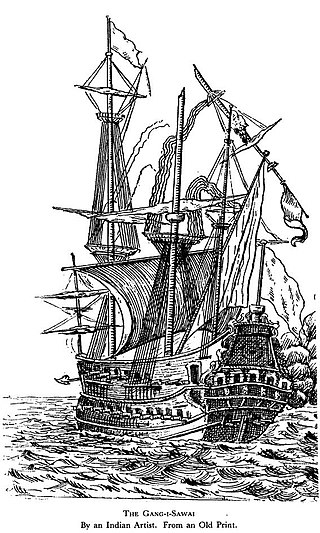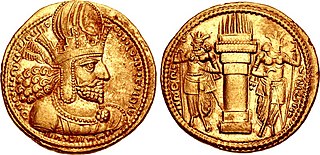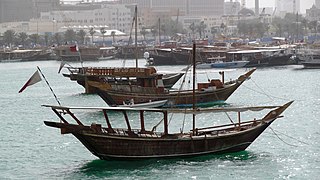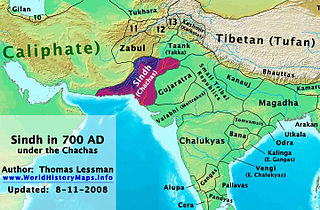
Sindh is a province of Pakistan. Located in the southeastern region of the country, Sindh is the third-largest province of Pakistan by land area and the second-largest province by population after Punjab. It is bordered by the Pakistani provinces of Balochistan to the west and north-west and Punjab to the north. It shares an International border with the Indian states of Gujarat and Rajasthan to the east; it is also bounded by the Arabian Sea to the south. Sindh's landscape consists mostly of alluvial plains flanking the Indus River, the Thar Desert in the eastern portion of the province along the international border with India, and the Kirthar Mountains in the western portion of the province.

Dhow is the generic name of a number of traditional sailing vessels with one or more masts with settee or sometimes lateen sails, used in the Red Sea and Indian Ocean region. Typically sporting long thin hulls, dhows are trading vessels primarily used to carry heavy items, such as fruit, fresh water, or other heavy merchandise, along the coasts of Eastern Arabia, East Africa, Yemen and coastal South Asia. Larger dhows have crews of approximately thirty, smaller ones typically around twelve.
Eudoxus of Cyzicus was a Greek navigator who explored the Arabian Sea for Ptolemy VIII, king of the Hellenistic Ptolemaic dynasty in Egypt.

Muḥammad ibn al-Qāsim al-Thaqafī was an Arab military commander in service of the Umayyad Caliphate who led the Muslim conquest of Sindh, inaugurating the Umayyad campaigns in India. His military exploits led to the establishment of the Islamic province of Sindh, and the takeover of the region from the Sindhi Brahman dynasty and its ruler, Raja Dahir, who was subsequently decapitated with his head sent to al-Hajjaj ibn Yusuf in Basra. With the capture of the then-capital of Aror by Arab forces, Muhammad ibn al-Qasim became the first Muslim to have successfully captured Hindu land, which marked the beginning of Muslim rule in South Asia.

Sindhis are an Indo-Aryan ethnolinguistic group native to the Sindh province of Pakistan. They generally speak Sindhi or various Sindhic dialects or languages, as their first language. The historical homeland of Sindhis is bordered by the southeastern part of Balochistan, the Bahawalpur region of Punjab and the Kutch region of Gujarat. Having been isolated throughout history unlike its neighbours, Sindhi culture has preserved its own uniqueness.

Kanhoji Angre, also known as Conajee Angria or Sarkhel Angré was a chief of the Maratha Navy in present-day India. Kanhoji became known for attacking and capturing European merchant ships and collecting jakat, seen by Europeans traders and colonists as ransoming of their crews. British, Dutch and Portuguese ships often fell victims to these raids. Despite attempts by the Portuguese and British to put an end to his privateering activities, Angre continued to capture and collect jakat from European merchant ships until his death in 1729. Kanhoji's naval prowess in capturing dozens of European trading ships and avoiding capture has led to many historians to appraise Kanhoji as the most skilled Indian navy chief in the maritime history of India.
Raja Dahir was the last Hindu ruler of Sindh in present-day Pakistan. In 711 CE his kingdom was invaded by the Umayyad Caliphate led by Muhammad bin Qasim where Dahir died while defending his kingdom. According to the Chachnama, the Umayyad campaign against Arori Raja Dahir was due to a pirate raid off the coast of the Sindhi coast that resulted in gifts to the Umayyad caliph from the king of Serendib(Old name of Sri Lanka) being stolen.

The history of Sindh refers to the history of the modern-day Pakistani province of Sindh, as well as neighboring regions that periodically came under its sway.
George Fadlo Hourani was a British philosopher, historian, and classicist. He is best known for his work in Islamic philosophy, which focused on classical Islamic rationalism and ethics.

The Ganj-i-Sawai was an armed Ghanjah dhow belonging to the Mughals. During Aurangzeb's reign, it was captured on 7 September 1695 by the English pirate Henry Every en route from present-day Mocha, Yemen to Surat, India. It was built on the order of Empress Mariam-uz-Zamani, great grandmother of Aurengzeb, after the capture of her ship named Rahimi.

Maritime history of Somalia refers to the seafaring tradition of the Somali people. It includes various stages of Somali navigational technology, shipbuilding and design, as well as the history of the Somali port cities. It also covers the historical sea routes taken by Somali sailors which sustained the commercial enterprises of the historical Somali kingdoms and empires, in addition to the contemporary maritime culture of Somalia.

Mansura, referred to as Brahmanabad in later centuries, was the historic capital of the caliphal province of Sindh, during the eighth century under the Umayyad Caliphate and then Abbasid Caliphate from the year 750 AD to 1006 AD. The city was founded as a central garrison by the Umayyad Forces in Sindh, the city transformed into a very vibrant metropolis during the Abbasid Era surpassing the wealth of Multan in the north and Debal in the south. Mansura was the first capital established by the Muslims in the Indian subcontinent after Muhammad bin Qasim seized the Brahmanabad territory. Mansura was built on the shores of the Indus River, it was surrounded by fertile farmland, Ibn Hauqal mentioned the wealthy local merchants who wore Baghdad Costume and were of Sindhi-Arab origins, houses were made of clay, baked bricks and plaster.
Ikaros was the Hellenistic name for what is now the Failaka Island of Kuwait. It is located 50 kilometres (31 mi) southeast of the spot where the Tigris and Euphrates empty into the Persian Gulf. For thousands of years, the island served as a strategic point in the Persian Gulf that would enable its ruler to control the lucrative trade that passed through the area; the island has been a strategic location since the rise of the Sumerian city-state of Ur in Mesopotamia.

Piracy in the Persian Gulf describes the naval warfare that was prevalent until the 19th century and occurred between seafaring Arabs in Eastern Arabia and the British Empire in the Persian Gulf. It was perceived as one of the primary threats to global maritime trade routes, particularly those with significance to British India and Iraq. Many of the most notable historical instances of these raids were conducted by the Al Qasimi tribe. This led to the British mounting the Persian Gulf campaign of 1809, a major maritime action launched by the Royal Navy to bombard Ras Al Khaimah, Lingeh and other Al Qasimi ports. The current ruler of Sharjah, Sultan bin Muhammad Al Qasimi argues in his book The Myth of Piracy in the Gulf that the allegations of piracy were exaggerated by the Honourable East India Company to cut off untaxed trade routes between the Middle East and India.
Pre-Islamic Arab trade refers to the land- and sea-trade networks used by pre-Islamic Arab nations and traders. Some regions are also known as the incense trade route. Trade has been documented as early as the beginning of the second millennium BCE.

The Iranian society in the Sasanian era was an Agrarian society and due to this fact, the Sasanian economy relied on farming and agriculture.

A Shu’ai, Shu’i or Shuw'i is a small or medium-sized dhow, a traditional Arabic sailing vessel. This type of dhow is built low with a high quarter deck and has one or two masts with lateen sails. A general purpose coastal boat, the shu’ai is one of the smaller-size dhow of Persian Gulf.

The Arab Empire maintained and expanded a wide trade network across parts of Asia, Africa and Europe. This helped establish the Arab Empire as the world's leading extensive economic power throughout the 8th–13th centuries according to the political scientist John M. Hobson. It is commonly believed that Mu‘awiya Ibn Abi Sufyan was the first planner and establisher of the Islamic navy.

The Umayyad conquest of Sindh took place in 711 AD and resulted in Sindh being incorporated into the Umayyad Caliphate. The conquest resulted in the overthrow of the last Hindu dynasty of Sindh, the Brahman dynasty of Sindh after the death of Raja Dahir.

Tulaji Angre, called Tulajee Angria by English historians was the grand admiral of the Maratha Navy and ruler of Colaba State in modern-day India. Similar to his famous father Kanhoji Angre, he too was an extremely skilled admiral and attacked several European trading ships. His achievements and naval prowess are considered to be greater than that of his father by some scholars and chroniclers. On various occasions he fought against the English, Dutch, Siddis And Portuguese maritime Powers. However, he alienated himself from the Maratha Peshwa, Balaji Baji Rao which led to his capture by the East India Company and Peshwa's forces at the Battle of Vijaydurg in 1756.
















